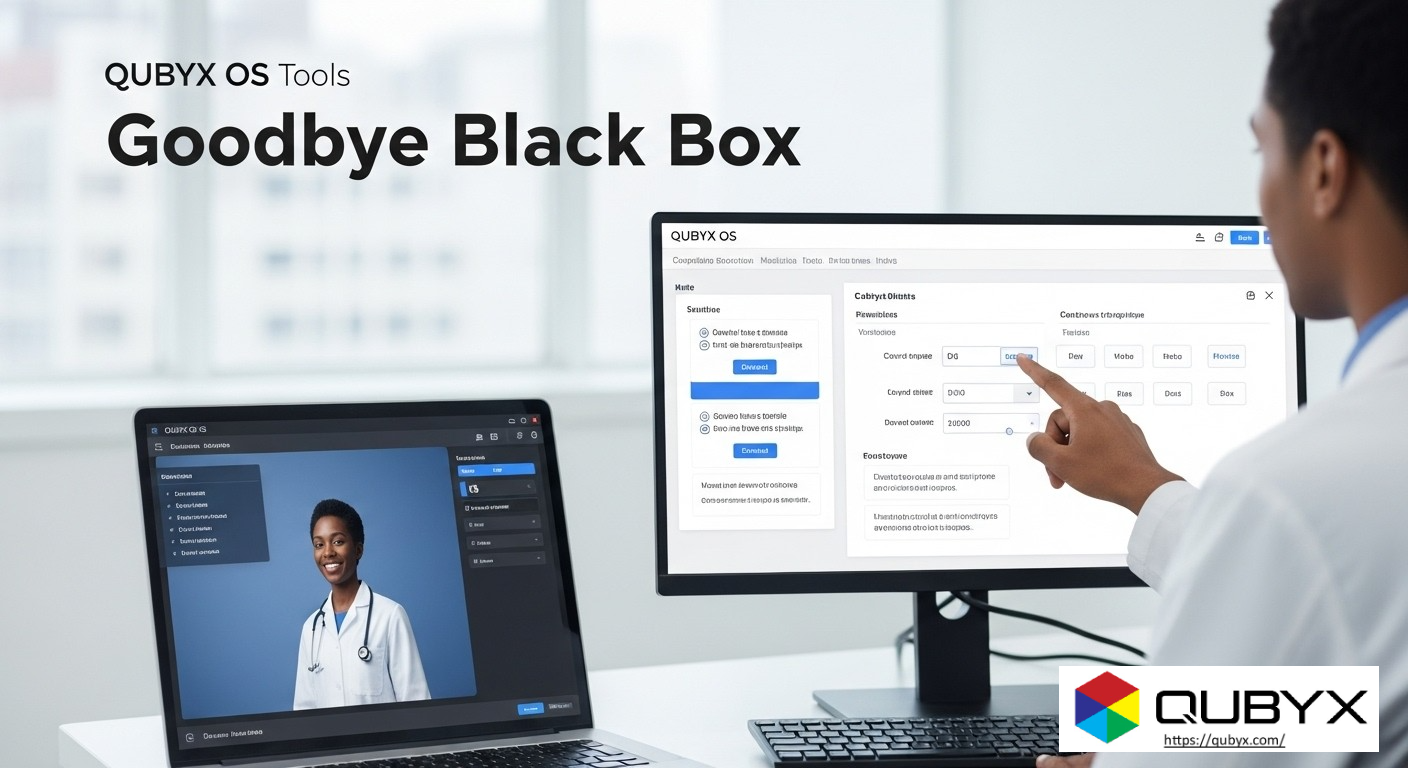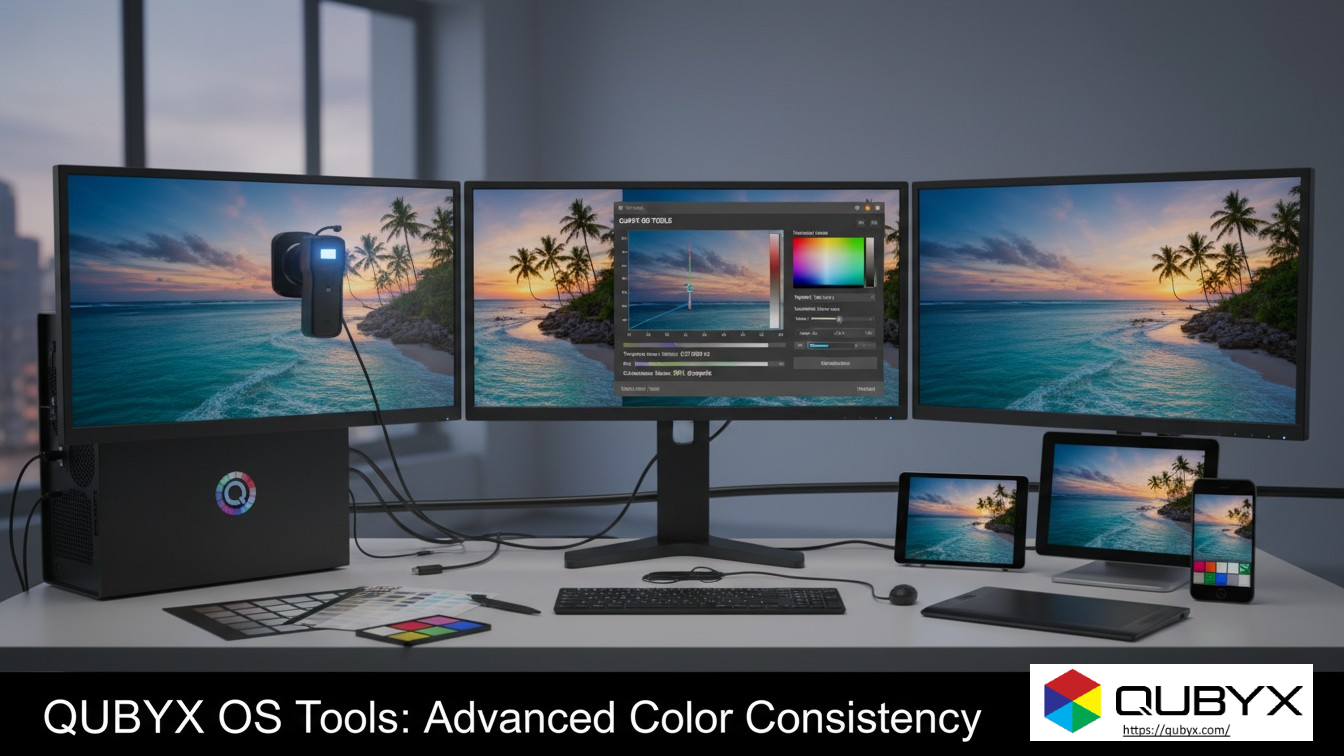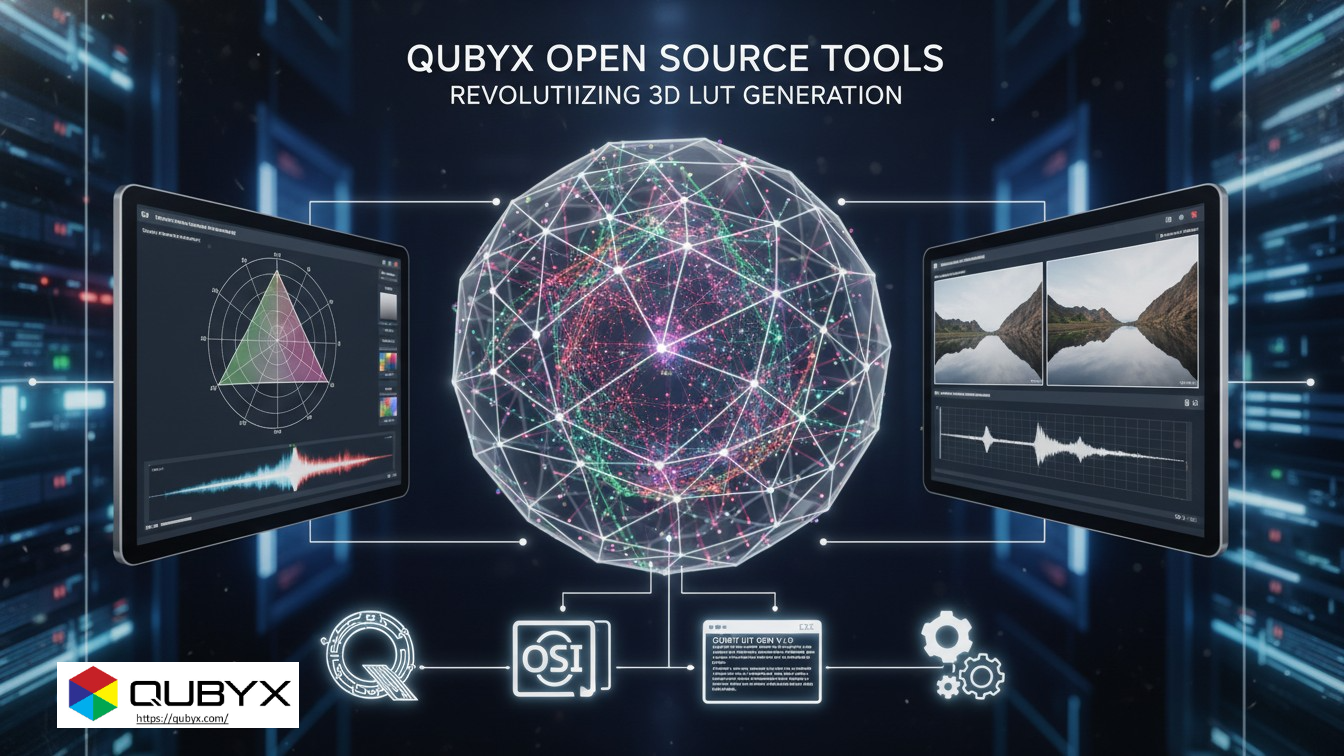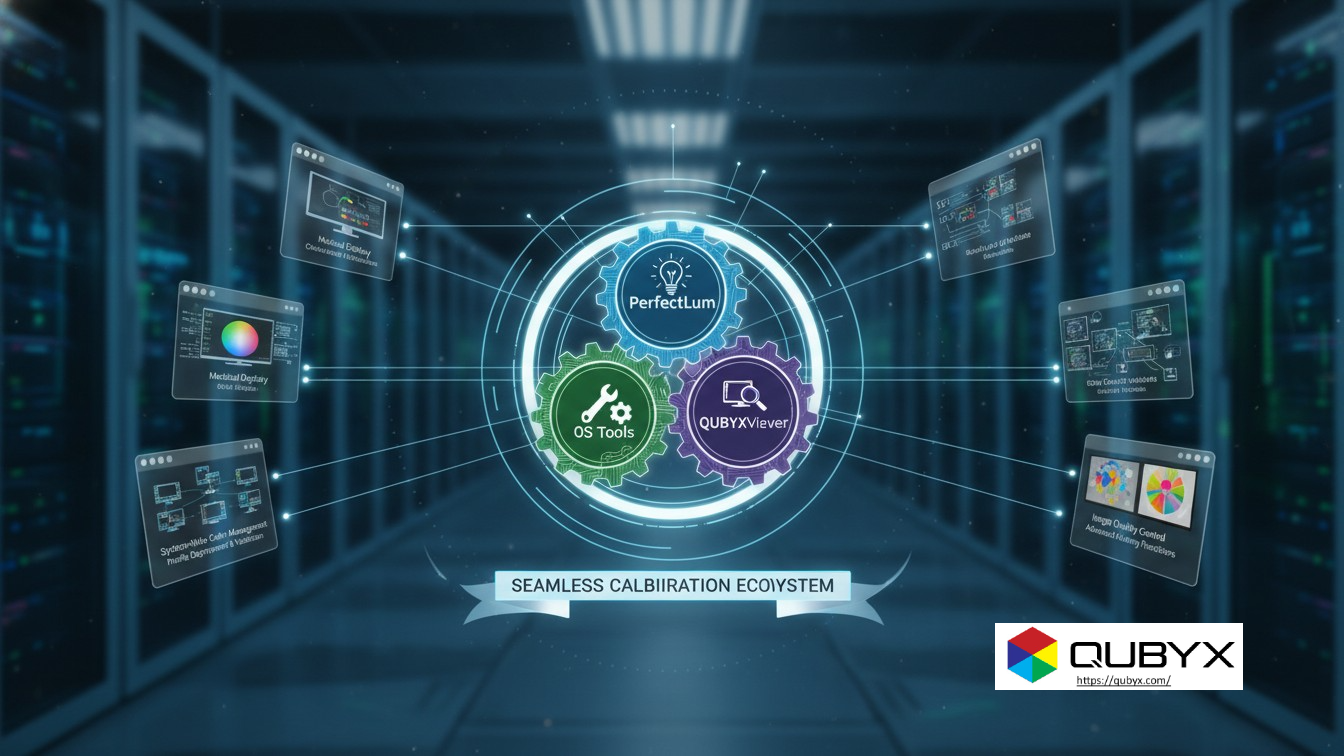News
- Home
- QUBYX OS Tools Calibration | Goodbye Black Box

QUBYX OS Tools Calibration | Goodbye Black Box
- October 17, 2025
- Shamsul
Goodbye Black Box | Simplifying Medical Display Calibration with User-Friendly QUBYX OS Tools
Why Calibration Feels Harder than it should
For years, “proper” display calibration in healthcare meant buying into closed, hardware-bound ecosystems: a particular monitor brand, a matching puck, and a labyrinth of vendor apps that only a few people dared to touch. That model hides complexity inside a literal and metaphorical black box—expensive, opaque, and hard to scale.
But the job to be done is simple: ensure that every pixel on every clinical workstation renders tone and contrast consistently so clinicians can trust what they see. QUBYX OS Tools flips the script with a software-first, user-friendly approach that removes mystery, reduces cost, and brings you standards-aligned results without locking you into proprietary gear.
What is QUBYX OS Tools—in plain language?
QUBYX OS Tools is a lightweight, open-minded calibration toolkit designed to generate precise ICC/Device-Link profiles (with 3D LUT logic) and apply them cleanly at the OS/GPU level. It works across a wide range of professional and mainstream displays, letting hospitals standardize image quality without ripping and replacing hardware.
Think of it as a calibration brain that:
-
Guides users through intuitive steps,
-
Builds a high-fidelity color/gray mapping,
-
Applies that mapping consistently system-wide,
-
And keeps it verifiable with routine QA checks (with PerfectLum, if you want full enterprise QA and reporting).
No more black boxes—just transparent, auditable, repeatable calibration.
What it Looks Like for Actual Users
For Radiologists & Clinicians
-
Consistent grayscale that aligns with professional expectations so subtle findings are easier to see and compare.
-
Predictable viewing from reading room to home teleradiology setup.
For IT & Imaging Physics
-
Vendor-agnostic deployments over diverse fleets (AOC, ASUS, Gigabyte, etc.).
-
Lower TCO by re-using capable displays and existing sensors.
-
Clear audit trail when used with PerfectLum for acceptance tests, drift checks, and compliance reporting.
For Administrators
-
Budget control: software-first calibration avoids costly “all-new monitor” refreshes.
-
Scale and standardize across sites, departments, and remote stations.
Key Benefits at a Glance
-
User-friendly workflow: a guided “wizard” flow that removes guesswork.
-
Hardware independence: leverage a wide spectrum of displays; avoid vendor lock-in.
-
3D LUT/Device-Link ICC power: tight tone/contrast control with robust gamut mapping.
-
Works with your ecosystem: pairs naturally with PerfectLum for acceptance testing, routine QA, and compliance reporting.
-
Future-proofing: software layers evolve faster than hardware refresh cycles.
How it Works (without the math headache)
-
Measurement: You (or IT) run the wizard with a supported meter to capture how the display actually behaves.
-
Modeling: QUBYX OS Tools builds a precise transform (3D LUT inside a Device-Link ICC) that tells the system how to translate pixel values into accurate luminance steps and colors.
-
Application: The profile is installed at the OS/GPU level so every app benefits—PACS, viewers, browsers, even telehealth portals.
-
Verification: Quick checks ensure the curve stays true. Pair with PerfectLum for scheduled QA, drift detection, and compliance records.
Standards & Quality Expectations (the practical view)
Clinical teams expect alignment with professional standards for grayscale and viewing conditions. A software-first path can support:
-
DICOM Part 14 GSDF behavior for grayscale conformance,
-
Structured QA against widely recognized methodologies (e.g., AAPM TG18 / TG270, DIN 6868-157),
-
Routine drift checks with pass/fail thresholds, screenshots, and PDFs when run through PerfectLum.
Translation: clinicians get consistent tone response, IT gets auditable proofs, and finance gets fewer surprises.
Quick-Start: From Zero to Calibrated
Time: 10–20 minutes per station (typical)
-
Prep the display
-
Warm up for 30 minutes.
-
Set native resolution and disable vendor “enhance” modes.
-
Fix brightness to a target (e.g., 120–160 cd/m² for reading rooms; adjust per local policy).
-
-
Connect your meter
-
Use a supported colorimeter or spectro.
-
Place it properly (center, no ambient glare).
-
-
Run QUBYX OS Tools (Wizard)
-
Select your target behavior (e.g., DICOM-like grayscale curve).
-
Start measurement; let the wizard step through patches automatically.
-
-
Create & apply profile
-
Generate the Device-Link ICC (with 3D LUT).
-
Apply system-wide and log the profile version.
-
-
Verify
-
Perform a quick verification; save the results.
-
Optional: schedule regular QA in PerfectLum (weekly smoke-check; quarterly full test).
-
Pro tip: Build a golden configuration per model/room type, then clone settings across similar stations to cut rollout time drastically.
Black-Box vs. Software-First (side-by-side)
| Dimension | Black-Box Ecosystems | QUBYX OS Tools (Software-First) |
|---|---|---|
| Hardware tie-in | High (brand-locked) | Low (vendor-agnostic) |
| Transparency | Opaque pipelines | Inspectable ICC/LUT logic |
| Upfront cost | High (proprietary) | Low-to-moderate (reuse displays) |
| Scale | Complex, brand-bound | Easy across mixed fleets |
| Updates | Firmware cycles | Rapid software iteration |
| QA & reporting | Often gated | PerfectLum gives rich QA, drift, reports |
Where it Shines (use cases)
-
Hospital radiology & teleradiology: normalize reading rooms and home stations.
-
Mammography prep & review stations (where allowed by policy): predictable grayscale behavior.
-
Dentistry, orthopedics, surgery dashboards: consistent tone and color across modalities.
-
Education & research: standardize labs with mixed hardware.
-
Telehealth imaging portals: reduce variability for clinicians and patients.
Governance, Policy, and Change Control
Introduce QUBYX OS Tools with simple governance:
-
Define targets: luminance, contrast, ambient light, and viewing distance per room type.
-
Set QA cadence: quick weekly checks; comprehensive quarterly; post-maintenance spot checks.
-
Version control: profile naming (site-room-model-date), PDF/CSV logs, change tickets.
-
Exception handling: what to do when a display fails thresholds (e.g., brightness below spec).
Result: calibration becomes boringly reliable, which is exactly what you want.
What About PerfectLum?
Think of PerfectLum as the enterprise QA and compliance layer:
-
Automates acceptance testing and routine QA.
-
Produces auditable reports for internal policy and external review.
-
Manages fleet-level scheduling, reminders, and pass/fail dashboards.
-
Complements QUBYX OS Tools so you have both accurate calibration and provable compliance.
Frequently Asked Questions
Q1: Can software-first match the feel of hardware LUTs?
Yes. With high-quality 3D LUT logic and correct installation at the OS/GPU level, you get precise grayscale/contrast control. In practice, clinicians care about consistency and verification; OS-level transforms deliver both when properly measured and applied.
Q2: Do we need to replace our monitors?
Not necessarily. If your current panels meet basic brightness/contrast and uniformity expectations, you can extend their useful life significantly with software-first calibration and routine QA.
Q3: Will it work with our PACS and viewers?
Yes. Because profiles apply at the OS/GPU layer, all applications benefit, including PACS, web viewers, and collaboration tools.
Q4: What if the display drifts?
That’s normal for any panel over time. Run quick checks, and let PerfectLum schedule and track QA; if a display falls outside thresholds, you’ll know exactly when and why.
Q5: Can we standardize across multiple sites?
Absolutely. Use a golden configuration and replicate. Pair with PerfectLum to centrally track adherence and exceptions.
Implementation Checklist
-
Define room-type targets (nits, ambient, policy).
-
Approve meters and standardize placement.
-
Create golden profiles per model/room.
-
Roll out via IT script or desktop management.
-
Turn on weekly quick checks, quarterly full QA.
-
Archive reports; enforce change control.
The Bottom Line
Calibration should not be a black art. QUBYX OS Tools brings clarity, control, and cost efficiency to medical display calibration—while PerfectLum adds the QA and reporting muscle enterprises need. Together, they let you reclaim quality without surrendering budget or flexibility.
Goodbye, black box. Hello, transparent, software-first calibration.
Learn more about QUBYX OS Tools and PerfectLum Suite — the most advanced Claibration software-first solutions for radiology, teleradiology, and clinical imaging environments.
Visit www.qubyx.com
To secure medical-grade display precision while reducing the recurring costs of proprietary hardware, the answer is clear: transition to a Calibration Software platform like QUBYX OS Tools (Free) and PerfectLum today.
Tags:
medical display calibration, DICOM GSDF, QA compliance, device-link ICC, 3D LUT, PerfectLum, teleradiology QA, software-first calibration, hospital imaging QA
Related Posts
- December 1, 2025
- News
How QUBYX OS Tools Deliver Next-Level Color Consistency The Hidden
- November 30, 2025
- News
Open-Source Tools for Medical Display QA: Why QUBYX Leads the
- November 29, 2025
- News
How QUBYX Open Source Tools Revolutionize 3D LUT Generation




